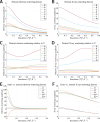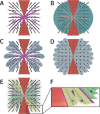Electron Diffraction of 3D Molecular Crystals
- PMID: 35970513
- PMCID: PMC9479085
- DOI: 10.1021/acs.chemrev.1c00879
Electron Diffraction of 3D Molecular Crystals
Abstract
Electron crystallography has a storied history which rivals that of its more established X-ray-enabled counterpart. Recent advances in data collection and analysis have sparked a renaissance in the field, opening a new chapter for this venerable technique. Burgeoning interest in electron crystallography has spawned innovative methods described by various interchangeable labels (3D ED, MicroED, cRED, etc.). This Review covers concepts and findings relevant to the practicing crystallographer, with an emphasis on experiments aimed at using electron diffraction to elucidate the atomic structure of three-dimensional molecular crystals.
Conflict of interest statement
The authors declare the following competing financial interest(s): J.A.R. is a founder and equity stake holder of MEDSTRUC INC.
Figures

 < 0.6 Å–1], equivalent
to [∞ < d < 0.83 Å]. (To convert
between
< 0.6 Å–1], equivalent
to [∞ < d < 0.83 Å]. (To convert
between  and d, recall Bragg’s
law:
and d, recall Bragg’s
law:  .) (B) Neutral X-ray
scattering factors.
(C) Neutral electron scattering relative to carbon. Relative scattering
amplitudes were calculated by dividing each scattering factor by f(s) for neutral carbon. (D) Neutral X-ray
scattering relative to carbon. (E) Ionic vs neutral
electron scattering factors for O and Fe. To avoid physically unrealistic
values in the limit as
.) (B) Neutral X-ray
scattering factors.
(C) Neutral electron scattering relative to carbon. Relative scattering
amplitudes were calculated by dividing each scattering factor by f(s) for neutral carbon. (D) Neutral X-ray
scattering relative to carbon. (E) Ionic vs neutral
electron scattering factors for O and Fe. To avoid physically unrealistic
values in the limit as  tends to zero, O1– was
truncated at 0.02 Å–1 before parametrization
into five Gaussians, while Fe2+ and Fe3+ were
truncated at 0.05 Å–1. (F) Ionic vs neutral X-ray scattering factors.
tends to zero, O1– was
truncated at 0.02 Å–1 before parametrization
into five Gaussians, while Fe2+ and Fe3+ were
truncated at 0.05 Å–1. (F) Ionic vs neutral X-ray scattering factors.








References
-
- Davisson C.; Germer L. H. Diffraction of Electrons by a Crystal of Nickel. Phys. Rev. 1927, 30, 705–740. 10.1103/PhysRev.30.705. - DOI
-
- Davisson C.; Germer L. H. The Scattering of Electrons by a Single Crystal of Nickel. Nature 1927, 119, 558–560. 10.1038/119558a0. - DOI
-
- Gehrenbeck R. K. Electron Diffraction: Fifty Years Ago. Physics Today 1978, 31, 34–41. 10.1063/1.3001830. - DOI
-
- De Broglie L. XXXV. A Tentative Theory of Light Quanta. Philosophical Magazine Letters 2006, 86, 411–423. 10.1080/09500830600914721. - DOI
-
- Thomson G. P.; Reid A. Diffraction of Cathode Rays by a Thin Film. Nature 1927, 119, 890–890. 10.1038/119890a0. - DOI

